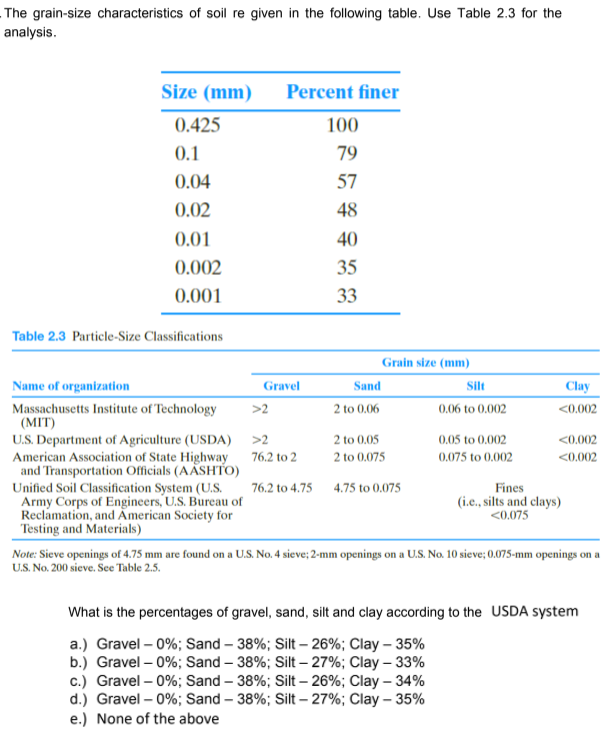The grain-size characteristics of soil re given in the following table. Use Table 2.3 for the analysis. Size (mm) Percent finer (0.425 100 0.1 79 0.04 57 0.02 48 0.01 40 (0.002 35 0.001 33 Table 2.3 Particle-Size Classifications Grain size (mm) Name of organization Massachusetts Institute of Technology (MIT) Gravel Sand Silt Clay >2 2 to 0.06 0.06 to 0.002 <0.002 U.S. Department of Agriculture (USDA) American Association of State Highway and Transportation Officials (AASHTO) Unified Soil Classification System (U.S. Army Corps of Engineers, U.S. Bureau of Reclamation, and American Society for Testing and Materials) >2 2 to 0.05 0.05 to 0.002 <0.002 76.2 to 2 2 to 0.075 0.075 to 0.002 <0,002 76.2 to 4.75 4.75 to 0,075 Fines (i.e., silts and clays) <0.075 Note: Sieve openings of 4.75 mm are found on a U.S. No. 4 sieve; 2-mm openings on a U.S. No. 10 sieve; 0.075-mm openings on a U.S. No. 200 sieve. See Table 2.5. What is the percentages of gravel, sand, silt and clay according to the USDA system a.) Gravel – 0%; Sand – 38%; Silt – 26%; Clay – 35% b.) Gravel – 0%; Sand – 38%; Silt – 27%; Clay – 33% c.) Gravel – 0%; Sand – 38%; Silt – 26%; Clay – 34% d.) Gravel – 0%; Sand – 38%; Silt – 27%; Clay – 35% e.) None of the above
The grain-size characteristics of soil re given in the following table. Use Table 2.3 for the analysis. Size (mm) Percent finer (0.425 100 0.1 79 0.04 57 0.02 48 0.01 40 (0.002 35 0.001 33 Table 2.3 Particle-Size Classifications Grain size (mm) Name of organization Massachusetts Institute of Technology (MIT) Gravel Sand Silt Clay >2 2 to 0.06 0.06 to 0.002 <0.002 U.S. Department of Agriculture (USDA) American Association of State Highway and Transportation Officials (AASHTO) Unified Soil Classification System (U.S. Army Corps of Engineers, U.S. Bureau of Reclamation, and American Society for Testing and Materials) >2 2 to 0.05 0.05 to 0.002 <0.002 76.2 to 2 2 to 0.075 0.075 to 0.002 <0,002 76.2 to 4.75 4.75 to 0,075 Fines (i.e., silts and clays) <0.075 Note: Sieve openings of 4.75 mm are found on a U.S. No. 4 sieve; 2-mm openings on a U.S. No. 10 sieve; 0.075-mm openings on a U.S. No. 200 sieve. See Table 2.5. What is the percentages of gravel, sand, silt and clay according to the USDA system a.) Gravel – 0%; Sand – 38%; Silt – 26%; Clay – 35% b.) Gravel – 0%; Sand – 38%; Silt – 27%; Clay – 33% c.) Gravel – 0%; Sand – 38%; Silt – 26%; Clay – 34% d.) Gravel – 0%; Sand – 38%; Silt – 27%; Clay – 35% e.) None of the above
Fundamentals of Geotechnical Engineering (MindTap Course List)
5th Edition
ISBN:9781305635180
Author:Braja M. Das, Nagaratnam Sivakugan
Publisher:Braja M. Das, Nagaratnam Sivakugan
Chapter2: Soil Deposits-origin, Grain-size, And Shape
Section: Chapter Questions
Problem 2.4P: For a soil, given: D10 = 0.08 mm D30 = 0.22 mm D60 = 0.41 mm Calculate the uniformity coefficient...
Related questions
Question

Transcribed Image Text:The grain-size characteristics of soil re given in the following table. Use Table 2.3 for the
analysis.
Size (mm)
Percent finer
0.425
100
0.1
79
0.04
57
0.02
48
0.01
40
0.002
35
0.001
33
Table 2.3 Particle-Size Classifications
Grain size (mm)
Name of organization
Gravel
Sand
Silt
Clay
Massachusetts Institute of Technology
(MIT)
>2
2 to 0.06
0.06 to 0.002
<0.002
2 to 0.05
0.05 to 0.002
U.S. Department of Agriculture (USDA)
American Association of State Highway
and Transportation Officials (AĂSHTO)
Unified Soil Classification System (U.S.
Army Corps of Engineers, U.S. Bureau of
Reclamation, and American Society for
Testing and Materials)
>2
<0.002
76.2 to 2
2 to 0.075
0.075 to 0.002
<0.002
Fines
(i.e., silts and clays)
<0.075
76.2 to 4.75
4.75 to 0.075
Note: Sieve openings of 4.75 mm are found on a U.S. No. 4 sieve; 2-mm openings on a U.S. No. 10 sieve; 0.075-mm openings on a
U.S. No. 200 sieve. See Table 2.5.
What is the percentages of gravel, sand, silt and clay according to the USDA system
a.) Gravel – 0%; Sand – 38%; Silt – 26%; Clay – 35%
b.) Gravel – 0%; Sand – 38%; Silt – 27%; Clay – 33%
c.) Gravel – 0%; Sand – 38%; Silt – 26%; Clay – 34%
d.) Gravel – 0%; Sand – 38%; Silt – 27%; Clay – 35%
e.) None of the above
Expert Solution
This question has been solved!
Explore an expertly crafted, step-by-step solution for a thorough understanding of key concepts.
This is a popular solution!
Trending now
This is a popular solution!
Step by step
Solved in 2 steps with 1 images

Knowledge Booster
Learn more about
Need a deep-dive on the concept behind this application? Look no further. Learn more about this topic, civil-engineering and related others by exploring similar questions and additional content below.Recommended textbooks for you

Fundamentals of Geotechnical Engineering (MindTap…
Civil Engineering
ISBN:
9781305635180
Author:
Braja M. Das, Nagaratnam Sivakugan
Publisher:
Cengage Learning

Fundamentals of Geotechnical Engineering (MindTap…
Civil Engineering
ISBN:
9781305635180
Author:
Braja M. Das, Nagaratnam Sivakugan
Publisher:
Cengage Learning